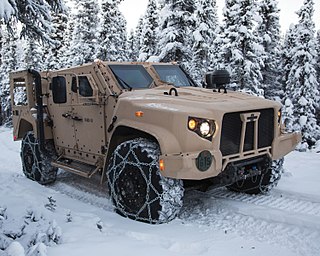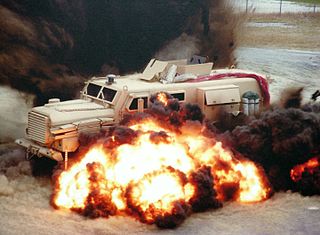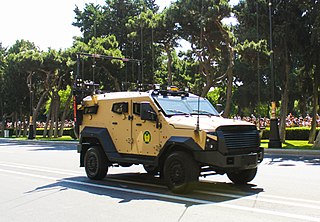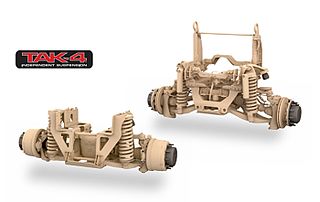
The High Mobility Multipurpose Wheeled Vehicle is a family of light, four-wheel drive, military trucks and utility vehicles produced by AM General. It has largely supplanted the roles previously performed by the original jeep, and others such as the Vietnam War-era M151 Jeep, the M561 "Gama Goat", their M718A1 and M792 ambulance versions, the Commercial Utility Cargo Vehicle, and other light trucks. Primarily used by the United States military, it is also used by numerous other countries and organizations and even in civilian adaptations.

Oshkosh Corporation, formerly Oshkosh Truck, is an American industrial company that designs and builds specialty trucks, military vehicles, truck bodies, airport fire apparatus, and access equipment. The corporation also owns Pierce Manufacturing, a fire apparatus manufacturer in Appleton, Wisconsin, and JLG Industries, a manufacturer of lift equipment, including aerial lifts, boom lifts, scissor lifts, telehandlers and low-level access lifts.

The Medium Tactical Vehicle Replacement (MTVR) is a series of vehicles used by the U.S. Marines. The first MTVRs were delivered in late 1999. The MTVR is the equivalent of the U.S. Army's Family of Medium Tactical Vehicles (FMTV); the Marines do not use the FMTV and the Army does not use the MTVR.

The International Extreme Truck Series is a range of pickup trucks produced by Navistar International from 2004 to 2008. The first International-brand vehicle marketed for non-commercial sale since 1980, the XT line also marked the return of the company to pickup truck production since the final generation of the (smaller) Light Line pickup trucks in 1975.

The Family of Medium Tactical Vehicles (FMTV) are a series of military vehicles based upon a common chassis, varying by payload and mission requirements. The FMTV is derived from the Austrian Steyr 12M18 truck, but substantially modified to meet United States Army requirements. These include a minimum 50 percent U.S. content.
Armor Holdings, Inc. was an American manufacturer of military, law enforcement, and personnel safety equipment. It was acquired by BAE Systems on July 31, 2007 and renamed BAE Systems Mobility & Protection Systems. The divisions have been reorganised within BAE Systems Land and Armaments.

The RG-33 is a mine-resistant light armored vehicle initially designed by BAE Systems Land Systems South Africa, a South African subsidiary of BAE Systems. BAE Systems in the US extensively modified it with additional protection, new powertrain, and suspension systems. It was built in a number of locations including York, Pennsylvania. It was one of several vehicles being fielded by the US Armed Forces in Iraq under the MRAP program.

The Joint Light Tactical Vehicle (JLTV) program was a U.S. Army, U.S. Marine Corps and Special Operations Command competition to select a vehicle to partially replace the Humvee fleet with a family of more survivable vehicles having a greater payload. Early studies for the JLTV program were approved in 2006. The JLTV program incorporates lessons learned from the earlier Future Tactical Truck Systems program and other associated efforts.

Mine-Resistant Ambush Protected is a term for United States military light tactical vehicles produced as part of the MRAP program that are designed specifically to withstand improvised explosive device (IED) attacks and ambushes. The United States Department of Defense MRAP program began in 2007 as a response to the increased threat of IEDs during the Iraq War. From 2007 until 2012, the MRAP program deployed more than 12,000 vehicles in the Iraq War and War in Afghanistan.
Plasan is an Israeli-based company that now specializes in survivability solutions for all domains, the design, development and manufacture of protected vehicles, and most recently maneuvering robotics.

The SandCat is a composite armored vehicle designed by the then Plasan Sasa of Israel. The SandCat was shown publicly for the first time at AUSA during October 2005. The latest models were shown for the first time at Eurosatory 2018. The SandCat is based on a commercial Ford F-Series chassis. Approximately 700 SandCats have been produced since 2004, and while Plasan has never released complete details, these are known to be in service with at least 16 users across five continents, and in a wide variety of roles that range from Police/internal security to combat/patrol.

The International M1224 MaxxPro MRAP is an armored fighting vehicle designed by American company Navistar International's subsidiary Navistar Defense along with the Israeli Plasan Sasa, who designed and manufactures the vehicle's armor. The vehicle was designed to take part in the US military's Mine Resistant Ambush Protected vehicle program, led by the US Marine Corps, as well as a similar US Army-led Medium Mine Protected Vehicle program.

The Humvee replacement process was an effort by the U.S. military to replace the current AM General Humvee multi-purpose motor vehicle. The Humvee had evolved several times since its introduction in 1985, and is now used in tactical roles for which it was not originally intended. The U.S. military pursued several initiatives to replace it, both in the short and long term. The short-term replacement efforts utilize commercial off-the-shelf (COTS) vehicles, while the long-term efforts focused on building requirements for the Humvee replacement and technology research and evaluation in the form of various prototype vehicles.

The M1120 HEMTT LHS is a M977 Heavy Expanded Mobility Tactical Truck with a load handling system in place of a flat bed/cargo body. The HEMTT is an eight-wheel drive, diesel-powered, tactical truck used by the US military and others. The HEMTT is manufactured by Oshkosh Defense and entered Army service in 1982, with the M1120 variant first produced in 1999.

The Oshkosh M-ATV is a mine-resistant ambush protected (MRAP) vehicle developed by the Oshkosh Corporation for the MRAP All Terrain Vehicle (M-ATV) program. Intended to replace M1114 HMMWVs (Humvee), it is designed to provide the same levels of protection as the larger and heavier previous MRAPs, but with improved mobility.

The Joint Light Tactical Vehicle (JLTV), known and marketed under Oshkosh development as the L-ATV, is a light utility/combat multi-role vehicle. The Oshkosh-developed JLTV was selected for acquisition under the US military's Army-led Joint Light Tactical Vehicle program. In the very early stages of the program it was suggested that JLTV would replace the AM General High Mobility Multi-purpose Wheeled Vehicle (HMMWV) on a one-for-one basis. It is now suggested that the JLTV will partially replace the HMMWV.

The Logistic Vehicle System Replacement (LVSR) is a family of heavy-duty military logistics vehicles of the United States Marine Corps (USMC) based on a common 5-axle ten-wheel drive (10x10) chassis. The vehicles vary in individual configuration by mission requirements, with three variants in service: a cargo, a wrecker and a tractor truck. The LVSR was designed and is manufactured by Oshkosh Defense.

TAK-4 independent suspension system is a family of independent suspension systems designed and manufactured by Oshkosh Corporation for use on military, severe-duty and emergency vehicles. The system was developed from the mid-1990s.
Navistar Defense LLC is a division of Navistar International that specializes in the manufacturing and design of military vehicles.
















